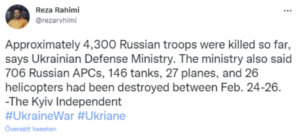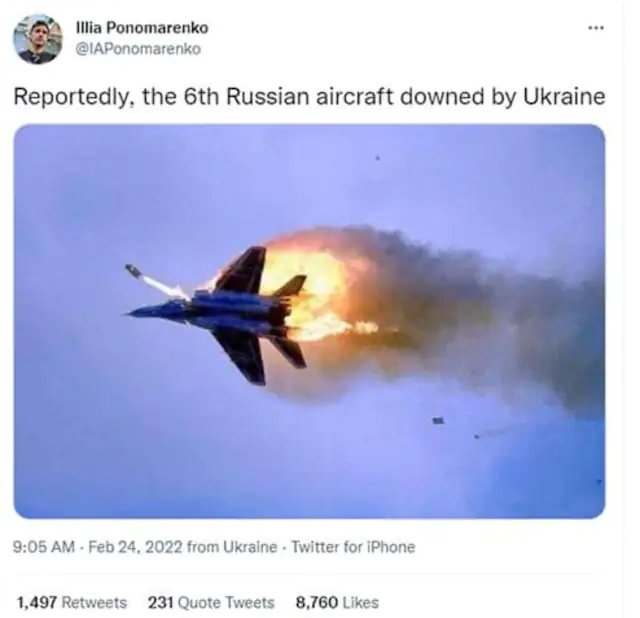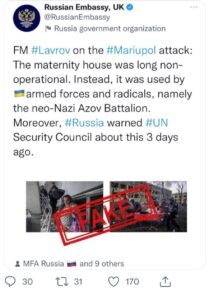NOTE: This page has not been updated since March, 2022 and may contain outdated information.
To practice source criticism, it can be helpful to operate as a fact-checker. There are different types of misleading information, and it is always useful to think about who is behind the data, what evidence is presented, and compare with other independent sources. It can also be a good idea to ask the following questions in a world of information disorder:
- Is it a false context? Is it, for example, a video, image, or statement in the wrong context?
- Is it fabricated content? Is it false evidence in the form of, for example, a video, image, or text?
- Is it a deliberate spreading of disinformation or unconscious dissemination of misinformation?
- In what ways can the spread of news be good and/or bad?
Here are some examples of news about the war in Ukraine that has circulated in the media.
Task
Your task is to examine whether the information is correct or misleading. Comment if you think it is misinformation or disinformation. Also, consider how harmful the information may be.
To determine the trustworthiness, it is practical to use digital tools such as Tineye, Google text and image search, or Bing text and image search. You can easily install InvidWeVerify or RevEye for quick access to various tools to fact-check images on your computer.
Exercise 1: On the way to the war?
Numerous people have shared this image of a Ukrainian soldier on her way to war. Is the information in this tweet posted on February 27th correct? Please watch this video to get some guidance on how to examine the picture. Is this accurate or misleading information (misinformation or disinformation)? In what ways can the news spread be good and/or bad?


Exercise 2: Damaged by bombs?
This picture of an injured woman is said on social media to derive from a gas accident in 2018 or be a picture of an actor who pretends to be a victim of bombings. Is this accurate information or any misleading information? Could the information be considered beneficial or harmful?

Exercise 3: A Russian plane is shot down here?
Illia states that the Ukrainian defense is shooting down a Russian plane in this tweet. The news was also distributed on a news site in Latvia. Is this correct or any misleading information (misinformation or disinformation)? Is there any benefit or harm to disseminating information via Twitter and news sites in Latvia?

Exercise 4: An iconic image from the war?
Former Swedish Prime Minister and Foreign Minister Carl Bild shared a picture from the ongoing war on Twitter, which he describes as very memorable. Is this correct or misleading information (misinformation or disinformation)? How can the dissemination of the information be good and/or bad?
![]()
Exercise 5: A Russian attack on nuclear power plant in Zaporizhia?
On March 4th, Mykhailo Podolyak posted a video with the comment, ”Zaporizhzhia nuclear power plant is under fire! The whole of Europe risks a repeat of the nuclear disaster. The Russians must stop the fire!” Is the information in the tweet correct, or is it misleading information (misinformation or disinformation)? In what ways can the dissemination of this information be good and/or bad?
Tip: It is not easy to do a reverse image search when reviewing videos. It is often better to do a text search to check what other credible sources say about the news.
Exercise 6: A bombed nuclear power plant in Luhansk?
On Twitter, Nguen Ken shared a video depicting a fire at a nuclear power plant in Luhansk, Ukraine, following a Russian airstrike. Find out if the video is appropriate proof of this. Is the information correct or any misleading information (misinformation or disinformation)? In what ways can the dissemination of this information be good and/or bad?
Exercise 7: A helicopter crashes a military vehicle?
Rob Lee posted a video on Twitter that shows how a Russian attack helicopter shoots down a Ukrainian military vehicle in Ukraine. The information comes from TikTok. Is the information correct, or is it misleading information? In what ways can the dissemination of this information be good and/or bad?
Exercise 8: Bombing the maternity clinic?
On March 9th, Mariupol was bombed in Ukraine. Among other things, a hospital with a maternity clinic was seriously injured in a Russian robot attack. The Russian Foreign Minister Lavrov subsequently made a statement about the incident. In the message (in the video below) shared on Twitter by the Russian embassy in the UK, Lavrov claims that it was a bombing of a haunt for radical military groups, not a maternity hospital with pregnant women. On Twitter and Facebook, the Russian embassy also wrote that the pictures of pregnant women were faked, with women pretending to be injured.
Is the information correct, or is it misleading information? In what ways can the dissemination of this information be good and/or bad?

